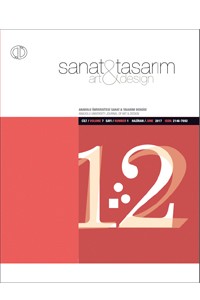Öz
İtalyan film yönetmeni Luchino Visconti odağına insanı alan “antropomorfik” sinema anlayışıyla birçok film yapmış, genellikle zamana yenilen kahramanları ve tutkuları
olan sıradan insanları anlatmıştır. Thomas Mann’ın aynı adlı kısa romanından uyarlayıp 1971’de tamamladığı Venedik’te Ölüm filminde, yeni yüzyıla girerken bir sanatçının ölümüyle birlikte bir devrin de kapanışını kültürel tarih, edebiyat, sinema ve müzik
sanatları arasında metinler arası göndermeler yaparak anlatmaktadır. Filmin müziğini
ise aynı devre ait besteci Gustav Mahler’in üçüncü ve beşinci senfonilerinden oluşturmuştur. Mahler’in müziği yine metinler arası ilişkilerin yardımıyla ana karakter Gustav von
Aschenbach’ın yaşamını, ruhsal durumunu ve iç sesini temsil etmekte, filmin anlatımına
ivme kazandırarak adeta bir başrol üstlenmektedir. Filmdeki ikirciklikler ve karşıtlıklar
Mahler’in müziğinde de görülmekte, bu paralellik de anlatımın gücünü ve etkisini artırmaktadır. Makale bu metinler arası ilişkileri inceleyerek Visconti’nin başyapıtına ve
filmde müzik kullanımına farklı bir bakış açısı getirmeyi amaçlamaktadır.
Anahtar Kelimeler
Visconti Mahler Metinlerarasılık Film müziği Antropomorfik sinema
Kaynakça
- Dyer, R. (2006). “Music, People and Reality: the Case of Italian Neo-Realism.”, European Film Music, Hazırlayan: M. Mera ve D. Burnand, Ashgate, Aldershot.
- Geitel, K., Prinzler, H.H., Schlappner, M. ve Schütte, W. (2006). Luchino Visconti. (Çev. Füsun Ant), ES Yayınları: Istanbul.
- Grange, H. L. de la (1999). Gustav Mahler Vienna: Triumph and Disillusion 1904-1907. Oxford University Press: Oxford.
- Hutchison, A. (2000). “Luchino Visconti’s Death in Venice.” http://www.culturecourt.com/Scales/film/DVenice.htm (erişim tarihi 3 Aralık, 2009)
- Mahler-Werfel, A. (1998). Diaries, 1898-1902 Alma Mahler-Werfel. (Çev. ve Hazırlayan Antony Beaumont), Cornell Uni- versity Press: New York.
- Mann, T. (1998). Death in Venice and Other Stories. (Çev. David Luke), Vintage Classics: London. Nietzsche, F. W. (1995) Thus Spoke Zarathustra (Çev. W. Kaufman). New York: Random House
- Premuda, N. (1995). “Luchino Visconti’s Musicism.” International Review of the Aesthetics and Sociology of Music, Sayı: 26(2), Croatian Musicological Society ve JSTOR, Sayfa: 189-210.
- Raj, P. P. E. (2015). “Text/Texts: Interrogating Julia Kristeva’s Concept of Intertextuality.” Ars Artium, Sayı 3, Sayfa: 77-80, Paragon International Publishers, Arar Saudi Arabia.
- Rudlin, J. (1999). Commedia dell’Arte: Oyuncular için El Kitabı. (Çev. Ezgi Ege İpekli), Mitos Boyut Yayınları: Istanbul.
- Thibault, P. J. (1994). “Intertextuality.”, The Encyclopedia of Language and Linguistics, 4, Hazırlayan: R. E. Asher, Perga- mum Press, Oxford.
- Vaget, H. R. (1980). “Film and literature. The case of “Death in Venice”: Luchino Visconti and Thomas Mann”, The German Quarterly, Sayı:53(2), Blackwell Publishing, New Jersey, Sayfa:159-175.
- Visconti, L. (Director). (1971). Death in Venice (Motion picture). United Kingdom: Warner Bros.
- Worton, M. ve Still, J. (1991). “Introduction.”, Intertextuality: Theories and Practices. Hazırlayan: J. Still ve M. Worton, Manchester University Press: Manchester.
- Tüm görseller aşağıdaki internet sitesinden alınmıştır:
- https://www.google.com.tr/search?q=death+in+Venice&espv=2&biw=1536&bih=735&source=lnms&tbm=isch&sa=X& ved=0ahUKEwj3yqivuJTRAhXCIsAKHfAZD-EQ_AUIBygC
- Makaledeki yabancı kaynaklardan alıntıların Türkçeye tercümeleri şahsıma aittir.
Öz
Italian film director Luchino Visconti and his “anthropomorphic” films took into
account the passionate and consuming nature of humans and mostly chose defeated
heros as their main characters. In his film Death in Venice (1971), adapted from Thomas
Mann’s short novel of the same name (1912), he tells the story of the death of an artist
and its relation to the closure of an era at the fin de siècle. The film constructs a web of
intertextual relations and quotations from cultural history, literature and music. Visconti’s
choice of non-diegetic music for the film is Mahler’s third and fifth symphonies. This is
no coincidence that Mahler and the main character Gustav von Aschenbach have many
things in common. Mahler’s music represents the life, spiritual state and inner voice of
Aschenbach, hence playing a leading role in the film. The dichotomies and ambiguities
in the film can also be traced in Mahler’s music, adding to the power and effect of the
narration. This study examines intertextuality in Visconti’s masterpiece and aims to
provide a different perspective on the use of music in film.
Anahtar Kelimeler
Visconti Mahler Intertextuality Film music Anthropomorphic cinema
Kaynakça
- Dyer, R. (2006). “Music, People and Reality: the Case of Italian Neo-Realism.”, European Film Music, Hazırlayan: M. Mera ve D. Burnand, Ashgate, Aldershot.
- Geitel, K., Prinzler, H.H., Schlappner, M. ve Schütte, W. (2006). Luchino Visconti. (Çev. Füsun Ant), ES Yayınları: Istanbul.
- Grange, H. L. de la (1999). Gustav Mahler Vienna: Triumph and Disillusion 1904-1907. Oxford University Press: Oxford.
- Hutchison, A. (2000). “Luchino Visconti’s Death in Venice.” http://www.culturecourt.com/Scales/film/DVenice.htm (erişim tarihi 3 Aralık, 2009)
- Mahler-Werfel, A. (1998). Diaries, 1898-1902 Alma Mahler-Werfel. (Çev. ve Hazırlayan Antony Beaumont), Cornell Uni- versity Press: New York.
- Mann, T. (1998). Death in Venice and Other Stories. (Çev. David Luke), Vintage Classics: London. Nietzsche, F. W. (1995) Thus Spoke Zarathustra (Çev. W. Kaufman). New York: Random House
- Premuda, N. (1995). “Luchino Visconti’s Musicism.” International Review of the Aesthetics and Sociology of Music, Sayı: 26(2), Croatian Musicological Society ve JSTOR, Sayfa: 189-210.
- Raj, P. P. E. (2015). “Text/Texts: Interrogating Julia Kristeva’s Concept of Intertextuality.” Ars Artium, Sayı 3, Sayfa: 77-80, Paragon International Publishers, Arar Saudi Arabia.
- Rudlin, J. (1999). Commedia dell’Arte: Oyuncular için El Kitabı. (Çev. Ezgi Ege İpekli), Mitos Boyut Yayınları: Istanbul.
- Thibault, P. J. (1994). “Intertextuality.”, The Encyclopedia of Language and Linguistics, 4, Hazırlayan: R. E. Asher, Perga- mum Press, Oxford.
- Vaget, H. R. (1980). “Film and literature. The case of “Death in Venice”: Luchino Visconti and Thomas Mann”, The German Quarterly, Sayı:53(2), Blackwell Publishing, New Jersey, Sayfa:159-175.
- Visconti, L. (Director). (1971). Death in Venice (Motion picture). United Kingdom: Warner Bros.
- Worton, M. ve Still, J. (1991). “Introduction.”, Intertextuality: Theories and Practices. Hazırlayan: J. Still ve M. Worton, Manchester University Press: Manchester.
- Tüm görseller aşağıdaki internet sitesinden alınmıştır:
- https://www.google.com.tr/search?q=death+in+Venice&espv=2&biw=1536&bih=735&source=lnms&tbm=isch&sa=X& ved=0ahUKEwj3yqivuJTRAhXCIsAKHfAZD-EQ_AUIBygC
- Makaledeki yabancı kaynaklardan alıntıların Türkçeye tercümeleri şahsıma aittir.
Ayrıntılar
| Birincil Dil | Türkçe |
|---|---|
| Bölüm | Makaleler |
| Yazarlar | |
| Yayımlanma Tarihi | 1 Haziran 2017 |
| Yayımlandığı Sayı | Yıl 2017 Cilt: 7 Sayı: 1 |


